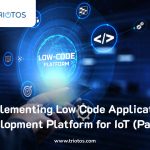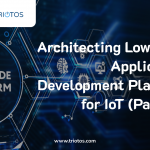
If you and your company are planning to implement an IoT solution (or updating an existing one), selecting and using an IoT Platform is a critical decision. The reason for this is not necessarily technology but the fact that it is the IoT platform that will enable nearly all the value of your IoT solution over time. Picking the right one is therefor of the essence. Before we discuss how, let us take a quick look at the functions an IoT Platform provides:
- Data Handling, Processing and Transformation
- Application Server for all IoT Applications (Fixed, web, mobile, APIs)
- Common Functions and Applications (data storage, IoT device handling and provisioning, connectivity management, security, user management and applications like analytics, ML, AI and company specific)
- Support of Edge and IoT Devices (agents, operating systems, stacks, connectivities, encryptions, management, updates)
The fact that many of these are technical tend to get in the way of what they are there to provide, product, service and business solutions that enhance your business and makes it more competitive. Data Handling, Processing and Transformation is only relevant if the data is processed and transformed into something meaningful for the business. Common functions must be looked at as supporting product and business objectives. Integrations are only meaningful if they enhance the business and solves current issues and problems. It is therefore business, not technical needs that should drive the choice. Needs associated with product, services, marketing, strategy, manufacturing distribution, operations, and financials.
While an IoT platform can operate in a total standalone mode within a business, in today’s 2023 business and technology environment it will most likely be and integral part of the business or business unit. This requires ability to integrate it with existing business functions (sales, marketing, services, distribution, production, finance, IT and more).
Finally, implementing IoT can still be a timely, expensive and risky proposition – For many companies, the road towards IoT has been littered with costly failures. Choosing and Using an IoT Platform in 2023 should therefore address the following needs:
- Meet current and future business needs
- Support integration with existing business functions
- Time of development, implementation, and introduction
- Overall cost of development, implementation, and operations
- Assessment of the risks involved
Taking these into consideration the decision comes down to choosing one of these five alternatives:
- Do it Yourself from Scratch
- Do it Yourself using Existing (premise or cloud) Platform
- Contract with IoT Platform Integrator
- Retain Systems Integrator to Develop IoT Solution
- Other Approaches
Let us discuss each of these alternatives in turn:
A – Do it Yourself from scratch is simply not viable today as creating an IoT platform from scratch is a multi-year effort that requires 20-30 engineers with widely varying skill sets. It is at $5+ million proposition taking at least 2 years requiring skill sets not available in most companies. No matter how enthusiastic your engineering or IT departments are, this is in 2023 no longer a viable alternative.
B – Do it Yourself using an Existing (premise or cloud) IoT Platform means that your team starts with an existing commercial platform supported by the company providing it. While this eliminates the platform development cost and time your team still must learn how to use the platform, develop all IoT applications and do all integrations. Depending on the platform chosen this will differ and platform providers may be more or less open as to what the real costs are. Regardless of this, you have to plan for substantial investments in engineering and integration capabilities as well as ongoing development costs. While this alternative may be appealing to many interest groups within a company it is only relevant for larger business that intend to create proprietary value around IoT capabilities and make this an integral part of their business. Needless to say, the company has to make a substantial investment in resources for solutions that will take at least a year to introduce.
C – Contract with IoT Platform Integrator is the option for companies that do not want to invest their own resources in developing and maintaining an IoT Platform and instead focus on creating value from IoT. IoT Platform Integrators come in different shapes and forms. The most common are Systems Integrator (SI) extension of IoT platform providers or stand-alone SIs specializing in one or several IoT platforms. The former will be true experts on their own platform while the latter vary in expertise ranging from ‘we will be the SI for the platform of your choice’ to ‘we specialize in providing SI services for this platform’. A third category are companies that have developed value-adding solutions on top of commercial IoT platforms like out of the box web and mobile applications or tools that makes it easy to integrate these platforms within a customer environment. These companies often use the cloud IoT offerings from Microsoft, AWS and others to base their solutions on. They range from SI body shops to companies offering complete, easy to customize and integrate solutions. Cost and time to implementation varies greatly among these alternatives but internal costs are reduced to critical areas like IoT devices, specialized applications, or integrations.
D – Retaining a Systems Integrator to Develop IoT Solution is an option for large and medium size companies that embark on full digitization of their business. Leading SIs like IBM, Wipro, SAP, Capgemini all have IoT practices and are ready to work with their clients to develop, source, customize and integrate IoT solutions to meet the client needs. Depending on these, solutions can be designed to meet any need and are often part of bigger projects to digitize a complete business and upgrade existing IT infrastructure. While SIs come in different sizes costs are typically in the $ millions with implementation times a year or more.
E – Other Approaches range from incorporating complete existing solutions from vendors complete with IoT devices, sensors and applications to customizing existing platforms from smaller providers. Examples of the former are tracking solutions complete with trackers and a couple of configurable applications. Examples of the latter are IoT device and sensor manufacturers that offer complete solutions targeting specific verticals. Just like with anything based on computing and communications there is no shortage of innovative solutions and new ones are introduced at a constant rate as any web search will show. Pricing models and price ranges are all over the map depending on business requirements.
So, Which Platform should I Choose or Use? As discussed above, developing a new one on your own is not a viable alternative in 2023. What is also clear is that business considerations, not technical ones, should drive the decision. Let us look at key ones:
- Company Size
- Role of IoT in Business
- Budget
- Business Requirements that IoT Should Support
- Technical and Implementation Needs
- Other
I – Company Size: What is the size of your company and derived from that, how much money can you set aside for IoT initially, and on a recurring yearly level.
II – Role of IoT in Business: Strategic Program or New Product/Services/Augmentations – this will decide the centrality of IoT in the business and therefore what the IoT Platform needs to do. A New Product/Services/Augmentations focus only requires an IoT Platform supporting these specific needs and can in many cases use an existing IoT service offering from an IoT supplier supported by feature requests. A Strategic Program means that IoT will be integrated with the business requiring a more flexible IoT platform that supports ongoing integration activities. The former will be part of normal product/service development function while the latter will be funded as a separate IoT function with its own staff (engineering and mgmt.) supporting other business functions.
III – Budget: What is the budget for IoT as reflected in staffing, investment, and ongoing operations. Is it $100k as part of product/service development or is it a multi-million effort. supporting internal organization and SI services. Is IoT part of overhead budgets like IT or is it part of the operational budget of business units and part of P&L.
IV – Business Requirements that IoT Platform Should Support: These will be different for each business, and it makes sense to think through what they, discuss them within the company and list them. A requirement is to know where customer systems are deployed for billing purposes is much easier than integrating system performance with service calls. Supporting 100 systems is different than 10,000 and require different solutions.
V – Technical and Implementation Needs: In most cases these are straightforward with the only unknown as to how these evolve over time. Most modern IoT platform support a wide variety of these needs and the deciding variable will be how evolving needs are supported and the cost of these.
VI – Time to Market: While in the past the normal time to market for new IoT Solutions was counted in years this is now changing to months. There is substantial value in being able to quickly test IoT solutions from both a technical and usability perspective. The old adage Time is Money is true even in IoT.
The biggest change in Choosing and Using IoT Platforms in 2023 versus previous years is that platform technical capabilities take the back seat and are overshadowed by business needs. The reason is a consolidation, maturing and segmentation of the platform market where we now have much fewer players providing IoT platforms reaching feature parity in their respective segments. The good news is also that IoT is getting cheaper so that small and medium companies can join the rapidly growing market of offering IoT based products, applications and solutions.
My company, Triotos, provides a rapid IoT onboarding solution built on top of the AWS IoT Core platform and other AWS services. It come with a complete set of customizable applications for data/vent monitoring and processing, analytics, administration and monitoring of the IoT solution and provisioning of IoT devices and is integrated with mobile networks and applications. This AWS cloud based solution scales from small local multi-tenant solutions to very large global solutions supporting thousands of devices. As part of our going to market approach we help you select the right IoT platform for your business and reduce the time to market and cost substantially.







